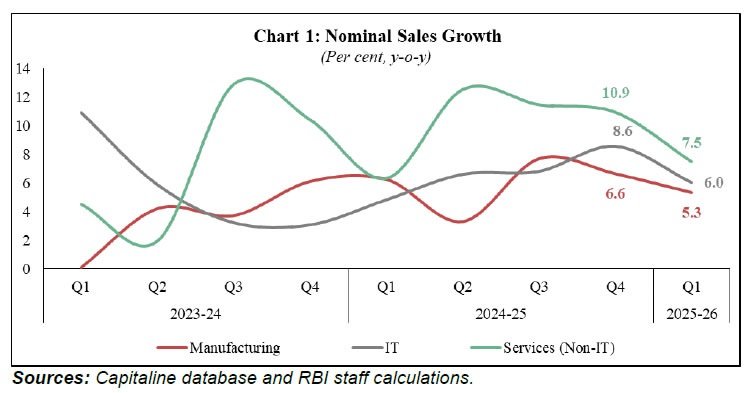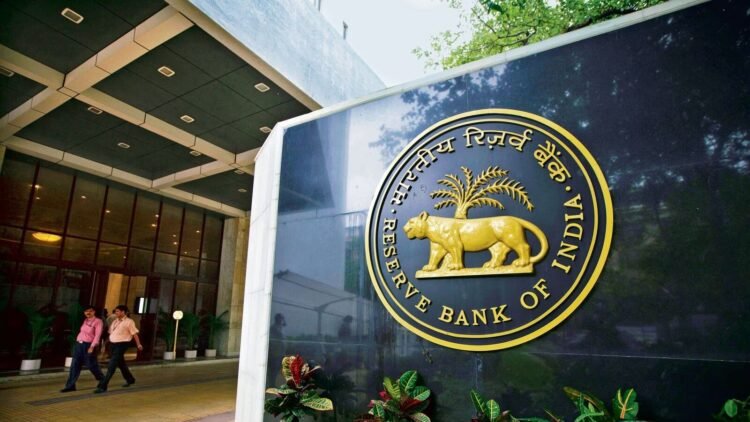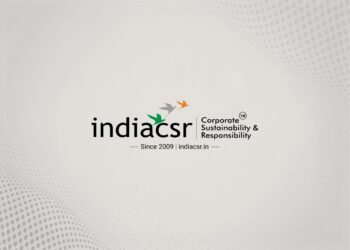RBI Data Shows Slower Sales Growth for Private Corporate Sector in Q1 FY2025-26
MUMBAI (India CSR): The Reserve Bank of India (RBI) has released the quarterly financial performance data of 3,079 listed private, non-government, non-financial companies for the first quarter (Q1) of FY2025-26. The data provides insights into how India’s private corporate sector is coping with evolving domestic and global market conditions. Compared with the previous quarter and the same period last year, the report reveals a picture of modest growth, sector-specific pressures, and cautious optimism.
Sales Growth Moderates Across Sectors
The RBI data shows that the overall sales of private companies rose by 5.5% year-on-year (y-o-y) during April–June 2025. While this is positive, it represents a slowdown compared to the 7.1% growth in the previous quarter (Q4 FY2024-25) and 6.9% growth in Q1 FY2024-25. This moderation indicates that demand, though improving, is stabilising rather than accelerating. For policymakers and businesses, the figures highlight the need to closely watch both consumer spending and export demand, which remain under pressure in certain industries.

Manufacturing Sector Weighed Down by Petroleum
The manufacturing sector, which represents the largest slice of corporate activity, recorded a 5.3% sales growth in Q1, down from 6.6% in the previous quarter. According to the RBI, this slowdown was mainly due to weak performance in the petroleum industry, a sector often sensitive to global crude oil prices and demand fluctuations. The petroleum slowdown dragged overall manufacturing, which otherwise showed resilience in some sub-sectors like engineering goods and chemicals. This suggests that while industrial production continues to grow, heavy reliance on petroleum leaves the sector exposed to global price shocks.
IT Sector Growth Slows After Strong Run
The Information Technology (IT) sector, often seen as a consistent growth driver for India, showed signs of cooling off. The report states that sales growth for IT firms dropped to 6% in Q1 FY2025-26, compared to 8.6% in Q4 FY2024-25. This decline comes after several quarters of rising momentum since early FY2024-25. Analysts suggest that global IT spending cuts, tightening client budgets in the US and Europe, and currency fluctuations may have contributed to this slowdown. Despite this dip, the IT sector continues to remain one of the strongest performers when compared to traditional manufacturing.
Services Sector Faces Transport Slowdown
The non-IT services sector reported 7.5% growth in sales during Q1 FY2025-26. While this appears strong, it is a notable moderation after the sector recorded double-digit growth in the last three quarters. The slowdown was largely attributed to weaker sales in the transport and storage industry, which has been facing cost pressures, subdued logistics demand, and rising competition. Still, other services such as hospitality and retail maintained healthy growth, indicating that urban consumption remains a supportive factor.
Raw Material Costs Ease for Manufacturers
On the expenditure side, the report highlights some relief for manufacturers. Raw material costs increased by 4.5% y-o-y, which is much slower compared to the 8.3% increase in the previous quarter. This moderation in input cost growth helped reduce the raw material-to-sales ratio to 54.1% in Q1 from 55.2% in Q4. The data suggests that softening commodity prices and supply chain improvements are providing breathing space to manufacturers, though the benefit varies across industries.
Staff Costs Rise But at a Slower Pace
Staff expenses, an important component of corporate spending, continued to rise across sectors but at a slower pace. For Q1 FY2025-26, staff costs increased 8.3% for manufacturing companies, 5.8% for IT companies, and 8% for non-IT services. These figures are lower than the previous quarter’s growth, pointing to controlled hiring and cautious wage revisions. The staff cost-to-sales ratio, however, edged up slightly, with IT companies spending the most at nearly 48.8% of their sales on employee costs. This underlines the labour-intensive nature of IT services, where talent remains the biggest investment.

Profitability Trends Diverge
Corporate profitability painted a mixed picture. Operating profit growth slowed to 6.9% for manufacturers and 11.3% for non-IT services companies, showing that both sectors are facing cost pressures and moderate demand. In contrast, IT companies saw a 5.4% sequential improvement in profits, supported by operational efficiency and pricing discipline. Consequently, operating profit margins improved for IT companies, remained stable for manufacturers, and softened slightly for non-IT services. The divergence suggests that pricing power is uneven across industries.
Debt Servicing Capacity Strengthens for Manufacturers
The report also provides insights into companies’ ability to service their debts. The interest coverage ratio (ICR) for manufacturing companies improved to 9.1 in Q1, up from 8.7 in the previous quarter, reflecting stronger profit growth. In the services sector, the ICR of non-IT services firms remained stable, while IT companies continued to enjoy a high ICR, signalling that they remain comfortably placed to meet interest obligations. This is an encouraging sign for lenders and investors, suggesting that corporate balance sheets remain relatively strong despite moderating growth.
(India CSR)






















